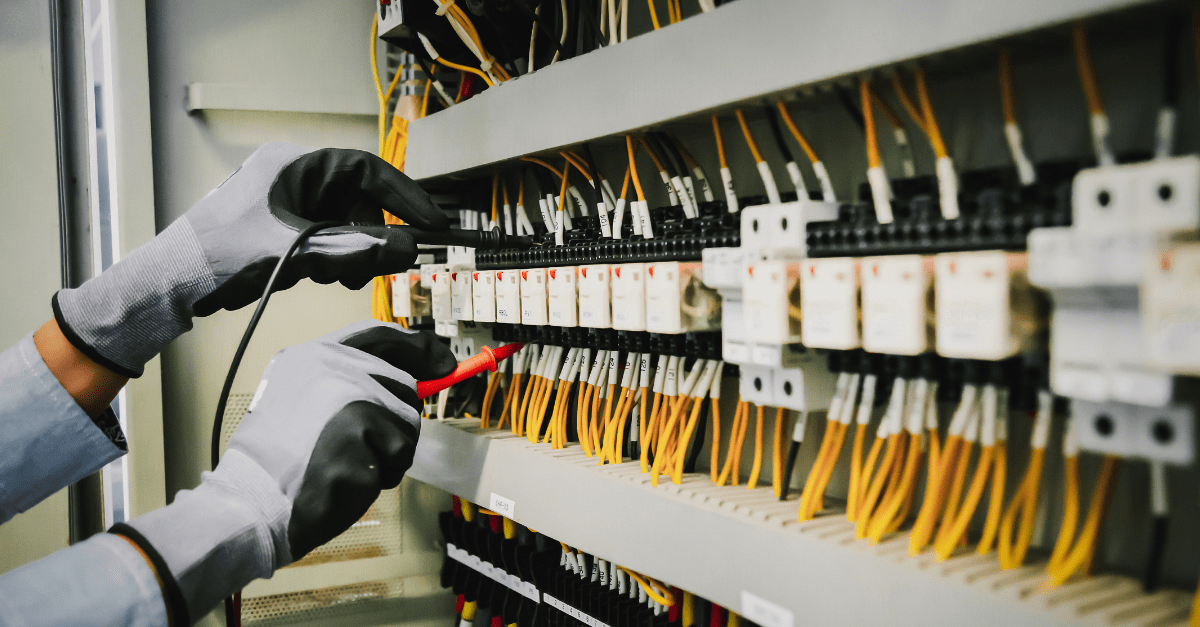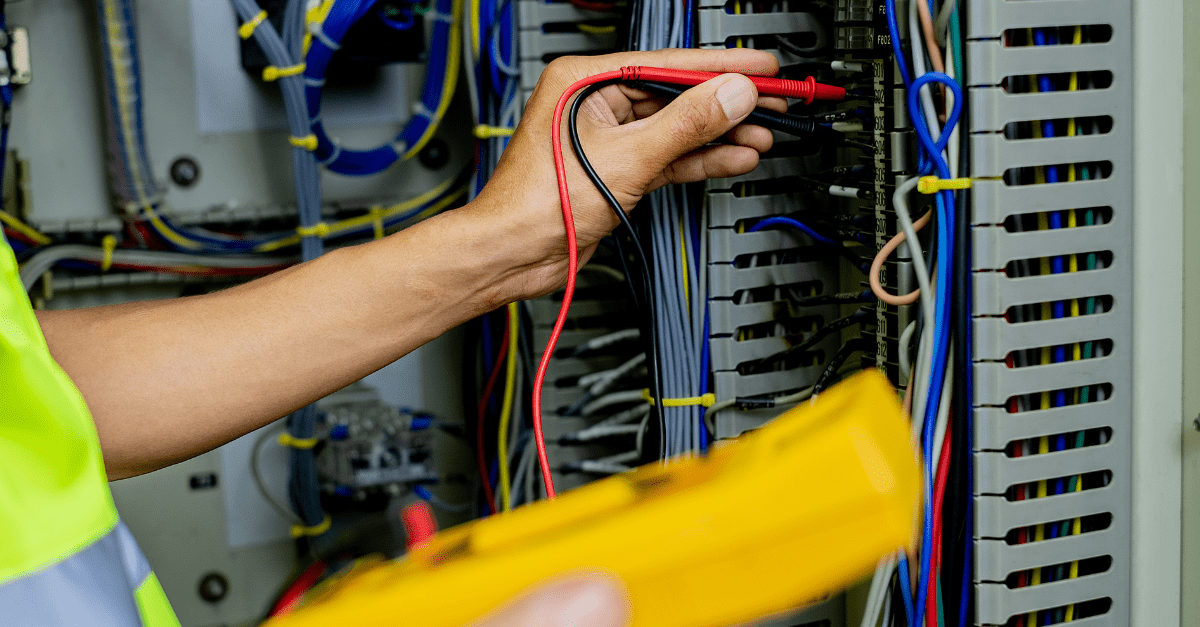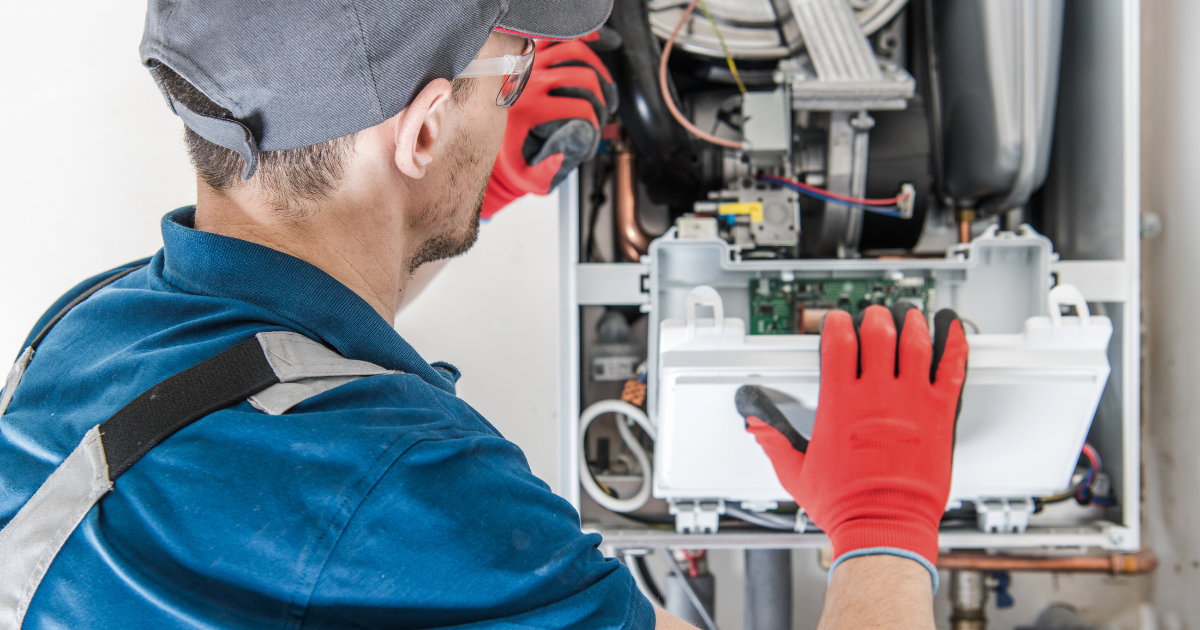From flagging fire hazards to identifying defective circuits, commercial electrical inspections and testing are vital for keeping staff safe. In this post, we’ll be walking you through how often your electrical system needs checking, how much you can expect to spend, and how an EICR certificate helps you to stay compliant with IET Wiring Regulations as an employer.
What are Electrical Systems Inspections?
Electrical systems inspections, also known as EICR inspections, are periodic electrical safety tests that should be conducted by qualified electricians. These tests are vital for checking the safety and functioning of your business’s circuits, wiring, and overall infrastructure. Following an electrical inspection, you’ll receive an EICR certificate. This will grade your electrics using the codes C1 (immediate danger and risk), C2 (possible danger), C3 (improvements suggested but not mandatory), and F1 (further investigation needed).
If your business’s electrical system is deemed satisfactory and you receive no C1, C2, or F1 codes, you are safe to continue your operations without taking any immediate action. This will act as evidence that you are compliant with the latest IET Wiring Regulations. However, if you receive ‘unsatisfactory’ on your report, you could be putting staff in danger and will need to act fast.
How Often Do You Need Electrical Inspections?
In terms of frequency, it’s recommended that commercial businesses have electrical inspections at least every five years. However, in industrial spaces, tests should be conducted more frequently – normally every one to three years. This is because of the volume of machinery, the potential for hazardous substances in the environment, and the heavy use of equipment.

How is Electrical Testing Different in Commercial Premises?
As you might expect, testing electrics in a commercial space is a more complex process and tends to happen more often than in domestic settings. Due to the larger scale, heightened safety requirements, and responsibility of the employer to comply with Electricity at Work Regulations, business electrical inspections should be conducted by specialists with experience in commercial systems.
What is an Electrical Inspection Certificate?
As we mentioned earlier on, following your electrical inspection, you’ll receive a document that grades your company electrics using numbers and letters. This certificate is called an EICR certificate and will tell you if any remedial action needs to take place.
Once your inspection is complete, the results will be reviewed and signed off by an NICEIC Qualified Supervisor before your certificate is issued. This process usually takes around two working days, but more complex assessments may take up to 3–5 days.
You can find out more info about EICRs in our NICEIC Electrical Installation Condition Report Guide EICR.
How Much Does an Electrical Inspection Cost?
While EICR inspections for houses tend to start at around £200-£250, it tends to vary significantly for businesses, since every commercial property is different. Normally, we price an inspection based upon how many circuits need testing. So, the more circuits you have, the higher the price will be.
Need a quick quote? Reach out to us using our simple contact form.

What’s the Difference Between Testing for EICR and Commercial PAT Testing?
Although both commercial PAT testing and EICR inspections are vital for keeping business electricals safe, there’s a distinct difference between the two. PAT testing focuses on portable electrical equipment with cables and plugs, whereas EICR testing focuses on wired-in electricals. This includes wiring, circuits, consumer units, fuse boards, and permanently wired appliances.
If you require both commercial PAT testing and EICR, let us know, and we can explore options for both.
Educating Staff on Electrical Safety in the Workplace
While electrical testing is paramount in all commercial premises, it’s also important to educate staff about safe practices when working with electrics. In an office or non-industrial setting, it can be easy to forget or overlook the electrical risks that come with these environments, but complacence can put staff safety at risk.
Common workplace risk factors include:
- Using unsafe cables or equipment from home, e.g. charging cables or plugs with exposed wires, or using chargers with the wrong wattage.
- Daisy-chaining extension cables
- Using tangled wires or ones that haven’t been fully uncoiled
- Using electricals that haven’t properly dried out after a spillage
- Overloading sockets with too many devices
- Attempting ‘DIY fixes’ on electrical equipment or sockets. E.g. using tape or similar to hold electricals in place
- Ignoring electrical smells or sounds like burning or hissing
Try to dedicate time to training staff about electrical safety, either in the form of a workshop, group meeting, or presentation. The more you demonstrate your commitment to staff safety, the easier it is for you to comply with the Health and Safety at Work Act 1974 and the Electricity at Work Regulations 1989.
Book an Electrical Inspection with Our Experts
If you need an electrical systems inspection for your commercial premises, we’re here to take care of everything. Our experienced NICEIC-certified electricians are always incredibly thorough and diligent, making sure all faults and risks are highlighted and addressed so that you can take the suitable steps needed to protect your staff and your business. If you’d like to find out more information about commercial electrical testing for your company, get in touch with our knowledgeable team today.



.png)
